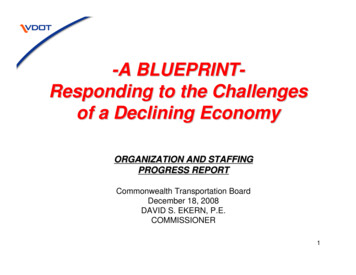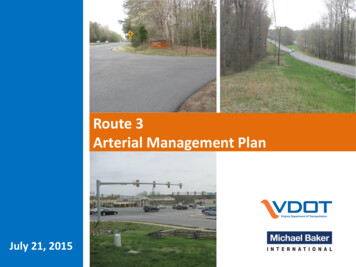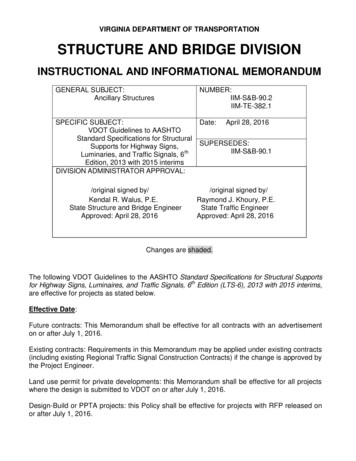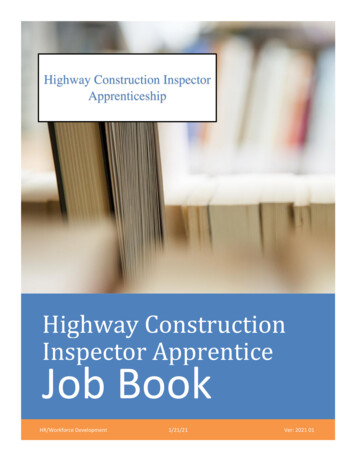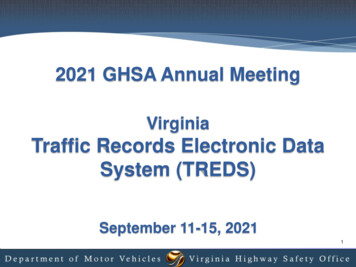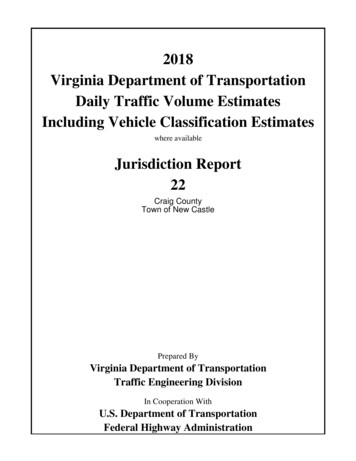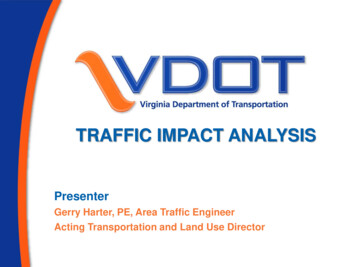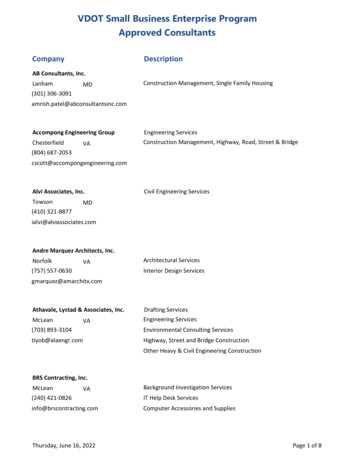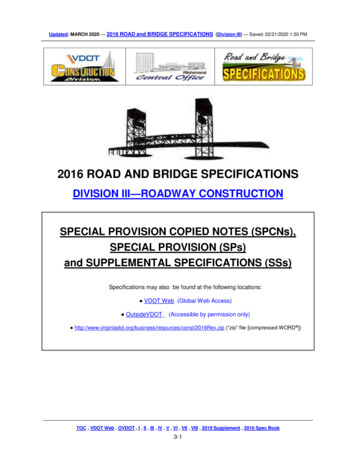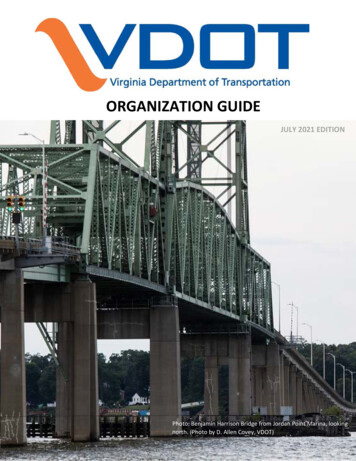
Transcription
ORGANIZATION GUIDEJULY 2021 EDITIONPhoto: Benjamin Harrison Bridge from Jordan Point Marina, lookingnorth. (Photo by D. Allen Covey, VDOT)
CHIEF OF TECHNOLOGY AND BUSINESS STRATEGY . 48TABLE OF CONTENTSINTRODUCTION. 3BUSINESS INTEGRATED SOLUTIONS . 49OVERVIEW . 4INFORMATION TECHNOLOGY. 51MISSION, VALUES, ETHICS . 5STRATEGIC INNOVATION . 53VDOT GOALS . 6CHIEF FINANCIAL OFFICER . 54VDOT ORGANIZATIONAL STRUCTURE . 7BUDGET AND FUNDS MANAGEMENT . 55VDOT ORGANIZATION CHART . 8FISCAL . 57COMMISSIONER . 9INFRASTRUCTURE INVESTMENT. 58ASSURANCE AND COMPLIANCE . 10TOLLING OPERATIONS . 60SAFETY, SECURITY AND EMERGENCY MANAGEMENT .12TRANSPORTATION PUBLIC-PRIVATE PARTNERSHIPS. 62CHIEF DEPUTY COMMISIONER. 14CHIEF OF POLICY. 64CIVIL RIGHTS . 15ENVIRONMENTAL . 65COMMUNICATIONS . 17GOVERNANCE AND LEGISLATIVE AFFAIRS . 66VIRGINIA TRANSPORTATION RESEARCH COUNCIL. 19LOCAL ASSISTANCE . 69VDOT DISTRICTS . 20RIGHT OF WAY/UTILITIES . 72VDOT DISTRICTS, VIRGINIA COUNTIES and INDEPENDENTCITIES . 21CHIEF ENGINEER . 74BRISTOL DISTRICT. 22CONSTRUCTION . 76CULPEPER DISTRICT. 23COST ESTIMATION . 78FREDERICKSBURG DISTRICT . 24LOCATION AND DESIGN. 79HAMPTON ROADS DISTRICT . 25MATERIALS . 82LYNCHBURG DISTRICT . 26STRUCTURE AND BRIDGE . 83NORTHERN VIRGINIA DISTRICT . 27TRANSPORTATION AND MOBILITY PLANNING . 84RICHMOND DISTRICT . 28APPENDIX . 86SALEM DISTRICT . 29VDOT WORKING GROUPS. 87STAUNTON DISTRICT . 30DISTRICT NAMES AND CODES . 88CHIEF OF MAINTENANCE AND OPERATIONS . 31CAPITOL SQUARE MAP . 89ASSET MANAGEMENT . 32COUNTY NAMES AND CODES . 90LAND USE . 33ROADMAP TO SUCCESS . 91ALTERNATIVE PROJECT DELIVERY . 75MAINTENANCE . 34OPERATIONS . 35TRAFFIC ENGINEERING. 37CHIEF OF ADMINISTRATION. 40ADMINISTRATIVE SERVICES . 41CAPITAL OUTLAY AND FACILITIES MANAGEMENT . 42HUMAN RESOURCES . 43INFORMATION SECURITY . 46PERFORMANCE TRANSFORMATION . 47VDOT ORGANIZATION GUIDE // 2
INTRODUCTIONVDOT proudly supports the Transportation quality, standard of living and economic development goalsof the Governor and the Secretary of Transportation. We work to ensure that Virginia is among the beststates in the country to live, work, run a business, attend school or visit.Continuous improvement is one of our core values. We learn from our successes and failures alike andfrom our public and private sector partners. Employees are encouraged to be problem solvers,challenging norms and exhibiting innovation.While we continue developing our expertise, we will also endeavor to develop as mentors and tostrengthen our next generation of experts and leaders.The Organization Guide details our major units, providing summaries of their products and services. ThePerformance Transformation Division updates the Organization Guide on a semi-annual basis.I-64 Widening Project, Segment 3, Hampton RoadsDistrict. Deck pour at the Queens CreekBridge. (Photo by Tom Saunders, VDOT)Go Orange Day April 2021 at the AreaHeadquarters in PulaskiVDOT ORGANIZATION GUIDE // 3
OVERVIEWVirginia has the third-largest state-maintained highway system in the country, behind only Texas andNorth Carolina. The Virginia Department of Transportation (VDOT) is responsible for building,maintaining and operation the roads, bridges and tunnels within the state. Through the CommonwealthTransportation Board, VDOT also provides funding for airports, seaports, rail and public transportation.The 128,772 lane mile state-maintained system is divided into these categories1: Interstate - 5,540 lane miles of four-to-ten lane highways that connect states and major cities Primary - 21,997 lane miles of two-to-six-lane roads that connect cities and towns with eachother and with interstates Secondary - 100,579 lane miles of local connector or county roads; these generally arenumbered 600 and above, and Arlington and Henrico counties maintain their own county roads Frontage - 656 lane miles of frontage roadsVirginia’s transportation network is more than roads2: More than 11,900 bridges and 7,550 culverts Six underwater crossings in the Hampton Roads area:- The mid-town and downtown Elizabeth River tunnels- The Hampton Roads Bridge-Tunnel on Interstate 64- The Monitor-Merrimac Memorial Bridge-Tunnel on Interstate 664- The two Chesapeake Bay Bridge Tunnel crossings Two mountain tunnels on Interstate 77 in southwest Virginia: East River and Big Walker Rosslyn Tunnel on Interstate 66 Eleven movable bridges Five Traffic Operations Centers and two Customer Service Centers Three toll roads (Northern Virginia’s Dulles Toll Road, The Powhite Parkway Extension nearRichmond, The Pocahontas Parkway near Richmond) One toll bridge (The George P. Coleman Bridge carries Route 17 traffic over the York Riverbetween historic Yorktown and Gloucester County; on northbound traffic is charged) Three ferry services (Jamestown-Scotland, Sunnybank, and MerryPoint) Forty-one safety rest areas and twelve welcome centers along major highways More than 100 commuter parking lots The Virginia Capital Trail bicycle and walking path1As2Asreported by VDOT’s Maintenance Division as of November 2019confirmed by VDOT Structure and Bridge Division on July 1, 2020The High Rise Bridge in Chesapeake carriesInterstate 64 over the South Branch of theElizabeth River. (Photo by Tom Saunders,VDOT)VDOT ORGANIZATION GUIDE // 4
MISSION, VALUES, ETHICSMissionOur mission is to plan, deliver, operate and maintain a transportation system that is safe, enables easymovement of people and goods, enhances the economy and improves our quality of life.Code of EthicsAs an employee of the Commonwealth of Virginia and the Virginia Department of Transportation, I will: Commit to be a trusted steward of public resourcesAct with integrity in all relationships and actions in the work environmentAbide by Virginia’s Standards of Conduct for employeesNot engage in conflicts of interest between my private interest and my professional roleNot use public resources for personal gainNot accept or give gifts in violation of the State and Local Government Conflict of Interests ActNot knowingly make a false or fraudulent statementNot knowingly conduct or condone any illegal or improper activityVDOT ORGANIZATION GUIDE // 5
VDOT GOALSVDOT ORGANIZATION GUIDE // 6
VDOT ORGANIZATIONAL STRUCTUREThe Virginia Department of Transportation (VDOT) currently has 7,735 approved full time positions.The agency has nine districts: BristolCulpeperFredericksburgHampton RoadsLynchburgNorthern VirginiaRichmondSalemStauntonDistricts are further divided into residencies and area headquarters in order to efficiently provide serviceto their geographically assigned areas.VDOT Central Office is in Richmond where the Commissioner’s Office and engineering, maintenance,operations and business support divisions are located.The Chief Deputy Commissioner reports to the Commissioner and provides direct leadership to fiveChiefs, nine District Engineers, the Virginia Transportation Research Council, the Civil Rights Division andthe Office of Communications.The Commissioner is appointed by the Governor to serve as the agency head or Chief Executive Officerof the agency. The Commissioner provides leadership for all agency staff and directly supervises theChief Deputy Commissioner, Chief Engineer and the offices of Assurance & Compliance and Safety,Security & Emergency Management.The Benjamin Harrison Bridge-is a vertical-lift bridgethat spans the James River between Jordan's Point inPrince George County and Charles City County nearHopewell, Virginia. (Photo by D. Allen Covey, VDOT)VDOT ORGANIZATION GUIDE // 7
VDOT ORGANIZATION CHARTVDOT ORGANIZATION GUIDE // 8
COMMISSIONERThe Commissioner is appointed by the Governor to serve as the agency head or Chief Executive Officerof the agency. The Commissioner provides leadership for all agency staff and directly supervises theChief Engineer, the Chief Deputy Commissioner, the offices of Assurance & Compliance and Safety,Security & Emergency Management.VDOT ORGANIZATION GUIDE // 9
ASSURANCE AND COMPLIANCEMissionAdvise the Commissioner of Highways, Commonwealth Transportation Board, Secretary ofTransportation, and Governor’s Office on core matters relating to the condition of agency accounting,financial and administrative controls, investigations to resolve allegations of fraudulent, illegal, and/orinappropriate activities, prevention and detection of fraud, waste, and abuse, and coordination withfederal and state law enforcement and prosecutorial agencies. Promote integrity, accountability,process improvements, and VDOT’s programs and goals by creating and working toward a shared visionof values and ethical behaviors.OverviewThe Office operates pursuant to authority contained within the “Audit Charter” that serves as the basicdocument in the organization and administration of the Virginia Department of Transportation,Assurance and Compliance Office (ACO). The Charter also serves to document ACO’s authorization toaccess records, personnel, and the physical properties relevant to the performance of audits andinvestigations, and to define the scope of the activities within VDOT and will coordinate activities withthe Office of State Inspector General necessary to support compliance with Virginia Code §2.2-309 et.seq.The Office provides independent and objective assurance services designed to add value to and improveVDOT’s operations. It helps VDOT accomplish its objectives by bringing a systematic, disciplinedapproach to evaluate and improve the effectiveness of risk management, control, and governanceprocesses, by providing effective control at reasonable cost. The Office also performs evaluations,reviews, and audits of external entities that conduct business with VDOT and investigates cases involvingallegations of fraud, waste and abuse, including those referred through the Commonwealth’s Fraud,Waste and Abuse Hotline.FunctionsThe Office is led by the Assurance and Compliance Office Director and performs the following functions: Internal Audits in accordance with the International Standards for the Professional Practice ofInternal Auditing (“IIA Standards”) to evaluate whether VDOT’s network of risk managementand internal control governance processes, as designed and represented by management, isadequate and functioning to ensure effectiveness and efficiency of operations; reliably conductsreporting; and is in compliance with policies, procedures, laws, and regulations Special Projects, including audits, reviews or investigations that are not scheduled on the AuditPlan based on the normal risk assessment process Investigations referred through the State Fraud, Waste, and Abuse Hotline and investigationsbased on detection, referral, or request by management of misconduct, policy misapplication, orfraud, waste, abuse or any other inappropriate activityVDOT ORGANIZATION GUIDE // 10
Reviews and Evaluations to determine compliance with the Federal Acquisition Regulation(“FAR”) including indirect cost rate (overhead) evaluations, final evaluations and pre-awardevaluations on external architectural and engineering firms, Comprehensive Annual FinancialReports (“CAFR”) evaluations, and CPA Workpaper Reviews on Indirect Cost Rate Audits Right of Way Ombudsman Evaluations which provide independent and objective reviews oflimited VDOT Right of Way actions, specific to eminent domain, that impact constituents ofVirginia Information Technology Security Audits develops and executes an annual audit plan of VDOT“sensitive” information technology systems in accordance with the Commonwealth’sInformation Technology Security Audit Standard (ITRM SEC502) Consultative Services are provided at the request of VDOT management and staffVDOT ORGANIZATION GUIDE // 11
SAFETY, SECURITY AND EMERGENCY MANAGEMENTMissionProvide agency-wide coordination and leadership for employee safety, security, emergencymanagement, and related planning through collaboration and consultation.OverviewThe Office of Safety, Security & Emergency Management is responsible for oversight of the safety,security, emergency operations, and emergency planning programs. The Office establishes policies,procedures, and best practices required to support, monitor, and evaluate these programs statewide.Through outstanding, around-the-clock customer service and innovative decision-support, the Office ofSafety, Security & Emergency Management supports a transportation system that is safe, strategic, andseamless.FunctionsThe Office is led by the Safety, Security & Emergency Management Director and consists of foursections: The Safety Section promotes safety as the first responsibility of all VDOT employees andreinforces that all personnel maintains a safe work environment. The Safety Section isresponsible for continuing to grow the safety culture among all VDOT employees andcontractors. By maintaining safety data and performing trend analysis on this data, the SafetySection supports the Districts and Central Office Divisions. This support is provided by theissuance of guidance and best practices on how to reduce injuries. Our ultimate goal is aworkplace free of Occupational Safety and Health Administration (OSHA) recordable injuries andzero preventable vehicle crashes. The Security Section develops projects to enhance employee and organizational situationalawareness and physical protection. The Security Section maintains multiple security systemsstatewide and serves as VDOT’s primary liaison for Homeland Security initiatives. The SecuritySection is also responsible for coordinating VDOT’s Critical Infrastructure Protection Program aswell as the responsibility for oversight and maintaining VDOT’s Criminal History and BackgroundCheck, Statewide Access Control, Credentialing, and Security Guard Services programs. The Emergency Operations Section monitors statewide incidents and events to determinepotential adverse impacts to the transportation system and coordinates and supports statewideemergency response and recovery operations. The Emergency Operations Section serves as theprimary liaison with the Virginia Department of Emergency Management and supports staffactivations of the Virginia Emergency Operations Center (VEOC) as well as coordination withother Virginia transportation agencies during events and incidents. The Emergency OperationsSection also supports the agency Customer Service Center (CSC) with non-peak (overnight)coverage.VDOT ORGANIZATION GUIDE // 12
The Emergency Planning Section prepares all-hazards Emergency Operations Plans (EOP),Continuity of Operations Plans (COOP), and Emergency Action Plans (EAP). The Section alsodevelops decision-support products for agency leadership that support situational awareness,effective deployments of personnel, efficient management of resources, and timely emergencyresponse and recovery.2018 Statewide Roadeo and Safety TrainingDay. (Photo by Tom Saunders, VDOT)VDOT ORGANIZATION GUIDE // 13
CHIEF DEPUTY COMMISIONERThe Chief Deputy Commissioner reports to the Commissioner and provides direct leadership to fiveChiefs, nine District Engineers, the Virginia Transportation Research Council, the Civil Rights Division andthe Office of Communications.VDOT ORGANIZATION GUIDE // 14
CIVIL RIGHTSMissionTransform, protect and enhance the quality of life for all by improving access to a fair and equitabletransportation systemOverviewThrough its internal and external programs and activities, the VDOT Civil Rights Division works to ensureinclusion, community and cultural awareness, and fair employment practices where federal and stateresources are applied in design, procurement and contracts.SectionsThe Division is led by the Civil Rights Director and encompasses two major sections, each of which arebroken into smaller teams: The Internal Programs Section works to provide equal opportunity employment to VDOTemployees. The Title VI Program is the “system of requirements” developed to implement Title VI of theCivil Rights Act of 1964 and civil rights provisions of other federal statutes and authorities to theextent that they prohibit discrimination on the grounds of race, color, or national origin inprograms receiving Federal financial assistance. The Disadvantaged Business Enterprise (DBE) Program is intended to increase the participationof DBEs on federally funded construction and consultant projects and to ensurenondiscrimination in the award and administration of federally funded projects. The VDOT Small Business Enterprise Program facilitates competition by small business firms toparticipate in procurements as prime contractors/consultants. The DBE, EEO, and Labor Compliance Program ensures that contractors and subcontractorsperforming work on federally assisted highway contracts comply with nondiscrimination andEEO, DBE commercially useful function, on-the-job training and labor requirements. The DBE Supportive Services Program offers business development services and trainings tocertified disadvantaged businesses to position them to obtain federally funded transportationcontracts. The Veterans Internship Program assists wounded veterans in making the transition to full-timeemployment within VDOT, other government agencies, or with private employers.VDOT ORGANIZATION GUIDE // 15
The External Programs Section administers nondiscrimination, affirmative action and equalopportunity programs that are legislatively mandated or developed to remedy or preventdiscrimination relating to VDOT contracting and external programs that use federal funds. The Title VII Program works to ensure equal employment opportunity (EEO) by prohibitingemployment discrimination based on race, color, religion, sex, or national origin. The Americans with Disabilities Act (ADA) Program is committed to complying with the ADA of1990 and the ADA Amendments Act (ADAAA) of 2008, which protect qualified applicants andemployees with disabilities from unlawful discrimination in recruitment, hiring, promotion,discharge, pay, training, fringe benefits, classification and other aspects of employment. The ADA/Section 504 Plan Program provides assurance that VDOT fully complies withrequirements of Section 504 of the Rehabilitation Act of 1973 and the ADA of 1990, as well asmeets all related U.S. Department of Transportation requirements.2015 DBE Transportation Training Symposium,Matchmaking Event. (Photo by Tom Saunders, VDOT)VDOT ORGANIZATION GUIDE // 16
COMMUNICATIONSMissionTo serve and engage both internal and external customers with professional communication services byproviding and presenting information that is accurate, clear, consistent, timely and accessible.OverviewThe Communications Division is responsible for strategic communications planning, executive counsel,internal and external communications, media relations, social media, web development and content,graphic design, photography, videography, cartography, procurement and advertising.SectionsThe division is led by the director of communications and consists of six major sections: The Content and Strategy Section provides accurate, timely information to internal and externalaudiences through a variety of communications mediums. This includes producing content forthe intranet homepage, electronic bulletin boards and other internal outreach initiatives. Thesection also maintains statewide and national media relations and works with subject matterexperts to draft and distribute news releases. Additionally, the section provides strategiccommunications planning, drafts talking points, develops presentations, supports the planningand execution of special events, produces the agency’s weekly report (Secretary’s Report),provides editing services and manages crisis communications. The Web Services Section assists internal stakeholders with design, front-end development andmaintenance of public-facing web properties that are optimized, user-friendly and 508compliant. The section also supports internal customers with implementing web contentupdates, virtual public meeting needs, content management system training and websitetechnical support. The Cartography Section produces maps, including the Official State Transportation Map, ScenicRoads in Virginia map, Bicycling in Virginia map, Historic Garden Week map, county maps andthe restricted structures atlas, along with many other customized maps. The Digital Media and Graphic Design Section develops strategy for the agency’s social mediaprogram, including day-to-day oversight. The section also maintains the agency’s designstandards and creates visual concepts, including logos and branding for websites, displays andvarious digital and printed publications. The Video and Photo Section produces still photographs and videos for internal and externalaudiences, including informational/educational videos, documentaries, training videos,animations and videos for social media. In addition to providing location, studio and portraitphotography, the section maintains an archive of photo and video assets.VDOT ORGANIZATION GUIDE // 17
The Business Section administers the division’s on-call marketing and communications servicescontract and manages procurement and legally-required advertising, including the placement ofpublic notices and ads. The section is also responsible for leading the distribution of the OfficialState Transportation Map and county maps.A media tour of the new Midtown Tunnel under constructionon the Portsmouth side. (Photo by Tom Saunders, VDOT)VDOT ORGANIZATION GUIDE // 18
VIRGINIA TRANSPORTATION RESEARCH COUNCILMissionProvide a substantive, nationally recognized applied research, development, consulting, and technologytransfer program to support the Virginia Department of Transportation in the planning, delivery,operation, and maintenance of Virginia’s transportation system.OverviewAs VDOT’s research division, the Virginia Transportation Research Council (VTRC) emphasizesimplementation of its research findings to improve agency operations, agency efficiency, and the safetyand quality of roadways in Virginia. VTRC conducts research in system operations and trafficengineering, structural engineering and materials science, pavement engineering, geotechnicalengineering, environmental science and engineering, transportation planning, and economics. Throughresearch in these disciplines and implementation of its findings, VTRC strives to introduce innovationsinto practice for the benefit of all who use Virginia’s transportation system.SectionsThe VTRC is led by the Research Council Director and Deputy Director and is organized into four majorresearch teams: The Pavements Team specializes in research on innovative materials, design, construction,evaluation, maintenance and management for highway pavements and related geotechnicalapplications The Structures Team specializes in research on innovative materials, designs, and preservationsand management strategies for bridges and other structures The Safety, Operations, and Traffic Engineering Team specializes in traffic engineering, trafficoperations and simulation, highway safety, human factors/driver behavior, intelligenttransportation systems, connected and automated vehicles, visualization/analysis/integration oflarge data sets, and performance measurement The Environment, Planning, and Economics Team specializes in finance, policy, cost/benefitanalysis, environmental studies, storm water management, historic preservation/management,multi- modal transportation, and transportation planningThe four research teams are supported by the Administration Team (general administrative/businesssupport), an Implementation Coordinator responsible for facilitating the implementation of research,and a technical editor responsible for VTRC publications.The VTRC also houses the VDOT Research Library, one of the largest specialized transportation librariesin the country with holdings of over 60,000 hard copy volumes of transportation related literature. Inaddition, the library’s 12 full-text subscriptions databases and eBooks offer patrons online access to over1.2 million items.VDOT ORGANIZATION GUIDE // 19
VDOT DISTRICTSDistrict InformationVDOT divides the state into nine districts, each of which oversees maintenance, operations, andconstruction on the state-maintained highways, bridges and tunnels in its region. Each district is led by aDistrict Engineer/Administrator. Within each district are residency offices, which handle oversight ofroadway maintenance, emergency response and land use for their geographic areas. Each residency isled by a Resident Engineer. Within each residency are area headquarters, or AHQs, at which a crew isstationed to perform maintenance work, such as patching potholes, mowing and plowing snow. EachAHQ is led by a superintendent.While some variations may exist, each district follows the basic structure below. There are AssistantDistrict Administrators (ADA) who oversee Maintenance, Operations, Construction, ProjectDevelopment, Business, and Programming and Investment Management programs within the district.Central Office divisions also provides support to districts, and the dotted line below represents thosefunctional areas. Personnel providing this support typically work out of the district office.VDOT ORGANIZATION GUIDE // 20
VDOT DISTRICTS, VIRGINIA COUNTIES and INDEPENDENT CITIESVIRGINIA COUNTIES and INDEPENDENT CITIESVDOT ORGANIZATION GUIDE // 21
BRISTOL DISTRICTGeographic AreasThe Bristol District comprises the 12 counties of Lee, Scott, Wise, Dickenson, Washington, Smyth,Russell, Buchanan, Grayson, Wythe, Bland and Tazewell, and includes the cities of Bristol and Norton.The district covers 5,500 square miles of the Commonwealth of Virginia and is home to 35,000 people.The district rests on predominately mountainous terrain and is located in the furthest most southwestpart of the state. The Bristol District borders four states: Kentucky, West Virginia, Tennessee and NorthCarolina. Interstate 81 in Washington, Smyth and Wythe counties and Interstate 77 in Bland and Wythecounties are part of the Bristol District. Main highway corridors in the Bristol District include Routes 460,19, 23, 58 and 11. CGI, AT&T, Sykes Enterprises, Crutchfield Corporation, Serco, and Verizon are amongthe technology companies with centers in southwest Virginia. Economic development opportunitiessuch as The Falls development at Interstate 81 Exit 5 in Bristol and the planned Hard Rock Bristol Resortand Casino at Exit 1 will bring new jobs and businesses to the region.Tourist Attractions and IndustryAs one of 9 VDOT districts, Bristol is one of the state’s most picturesque areas, rich in natural beauty andtourism opportunities. From stops along the Crooked Road Music Trail, to the Heartwood Artisan Centerin Abingdon and the Birthplace of Country Music Museum in Bristol, southwest Virginia is alive withmusical heritage and mile-high mountains.VDOT ORGANIZATION GUIDE // 22
CULPEPER DISTRICTGeographic AreasThe Culpeper District comprises the counties
Security Section. develops projects to enhance employee and organizational situational awareness and physical protection. The Security Section maintains multiple security systems statewide and serves as VDOT's primary liaison for Homeland Security initiatives. The Security
